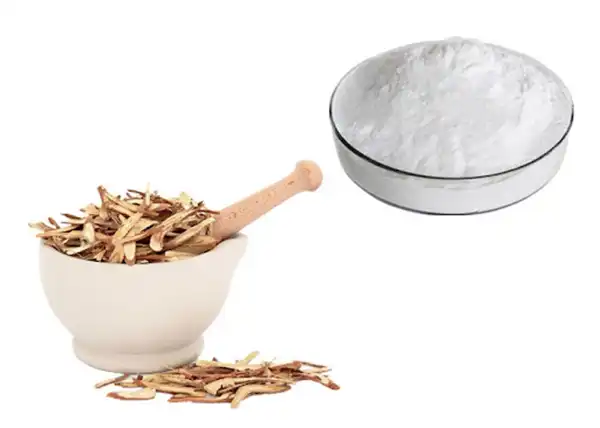What Foods Contain Glycyrrhizic Acid?
2024-06-20 12:07:10
Glycyrrhizic Acid in Licorice Roots
Glycyrrhiza glabra is one of the greatest sources of glycyrrhizic acid. It has been utilized in traditional medicine and confections. Licorice root extract is frequently added to candies, drinks, and herbal teas as a flavoring component.
The well-known flavor and medicinal properties of the herb licorice are attributed to a compound called Glycyrrhizic Acid Powder. Native to regions of Europe and Asia, glycyrrhizic acid powder is a plant whose roots are rich in this powerful chemical.
Licorice root extract's distinctive sweetness is ascribed to the triterpene glycoside molecule known as glycyrrhizic acid, or glycyrrhizin. Its distinct pharmacological properties are assumed to be caused by its molecular structure, which consists of two glucuronic acid molecules joined to a glycyrrhetinic acid molecule.
It has been utilized in traditional medicine for a very long time due to its numerous health benefits. It can be found in herbal medicines for a range of ailments, from coughs and sore throats to digestive issues because of its antioxidant, antiviral, and anti-inflammatory qualities,
It has attracted interest because of its possible pharmacological uses outside of traditional medicine. Research shows that it is benefical to prevent the proliferation of several viruses, including the herpes simplex virus and the severe acute respiratory syndrome coronavirus (SARS-CoV). The development of new antiviral medications has been prompted by this antiviral action.
It has a lot of health benefits. But too much of it might have negative effects. Prolonged intake of high doses has been associated with hypertension, hypokalemia, and edema due to its ability to inhibit the enzyme responsible for cortisol metabolism.

Glycyrrhizic Acid in Traditional Chinese Medicine
Traditional Chinese Medicine (TCM) also utilizes licorice root, known as "gan cao," for its medicinal properties. It is commonly used with other plants to enhance the therapeutic benefits of herbal remedies. In TCM, licorice root is believed to harmonize the various components of a formula and mitigate any potential side effects of other herbs.
Because of its many therapeutic uses, glycyrrhizic acid powder is a potent bioactive molecule that is highly appreciated in Traditional Chinese Medicine (TCM). This vital component has been utilized in herbal remedies. And it is derived from the roots of the Glycyrrhiza glabra plant.
In TCM, it is prized for its ability to harmonize and regulate bodily functions. It is frequently used as a component in formulations intended to relieve gastrointestinal discomforts such indigestion, bloating, and gastritis because of its purportedly relaxing impact on the digestive tract.
Moreover, it's anti-inflammatory properties are established. In Traditional Chinese Medicine (TCM), these qualities are essential for the treatment of inflammatory-related illnesses such as coughs, sore throats, and respiratory infections. It is a crucial component of herbal remedies for respiratory ailments.
Apart from its ability to relieve immediate symptoms, TCM regards it for its adaptogenic qualities, which aid in stress management and enhance general health. It aids individuals in developing more resilience and regaining their composure in the face of physical or psychological hardship by controlling the stress response and enhancing adrenal function,
Beyond its traditional application, it in TCM has been shown to have additional potential benefits by modern study. Research indicates that it might have antiviral qualities that prevent the spread of some viruses, such as the hepatitis C and herpes simplex viruses.
As with any herbal medicine, however, care must be taken to prevent negative consequences from overconsumption. Because it excess can cause hypertension and potassium shortage, moderation and informed use are essential.
Glycyrrhizin powder in Pharmaceuticals
Licorice roots are the source of it, a bioactive compound with numerous medicinal applications due to its varied pharmacological properties.Numerous studies and applications of Glycyrrhizin powder have been conducted in the medical domain.
Glycyrrhizin powder is mostly used in pharmaceuticals as a natural sweetener and flavoring in medications. It is a popular option for reducing the bitterness of many different medications because of its strong sweetness; this is especially true when used in liquid form as syrups and elixirs. It improves medication adherence and patient compliance by flavoring meals.
Furthermore, it possesses potent anti-inflammatory qualities that make it a common ingredient in drugs for inflammatory conditions including arthritis and dermatitis. Its inflammatory cascade-inhibiting enzyme qualities and pro-inflammatory cytokine qualities make it a valuable therapeutic element in formulations meant to reduce the pain and edema associated with these conditions.
It's hepatoprotective properties have also brought attention to it, making it a good alternative for treating liver illnesses. Studies show that it has hepatoprotective effects by promoting liver regeneration, preventing liver fibrosis, and improving liver function. For this reason, it is included in drug formulations intended to support liver function and facilitate detoxification.
It possesses antiviral qualities in addition to its hepatoprotective and anti-inflammatory ones, which may help treat viral infections. Research has shown that it works well against a variety of viruses, including HIV, the hepatitis B and C viruses, and the herpes simplex virus. This antiviral action has stimulated research into its potential use in combination treatments and antiviral drugs.
However, despite its promising pharmacological properties, it is not without limitations and safety concerns. Prolonged use or high doses may lead to adverse effects such as hypertension, hypokalemia, and fluid retention due to its mineralocorticoid-like activity.

Glycyrrhizic Acid in Food and Beverages
Apart from licorice root, glycyrrhizin powder can also be found in certain food products and beverages. Some examples include:
- Sweets and Confectionery: Licorice-flavored candies and sweets often contain it for its sweet taste.
- Beverages: Certain herbal teas, especially those with a licorice flavor, may contain it.
- Alcoholic Beverages: Some alcoholic beverages, particularly certain types of beer and spirits, may use licorice as a flavoring agent, which could contain it.
Conclusion
Glycyrrhizic acid is a substance used in food, medicine, and traditional medicine. Its existence in licorice root and many food products highlights its relevance in various cultures and sectors. Learning about its history and applications can make it easier for you to comprehend the risks and possible health benefits of eating it.
Xi'an ZB Biotech Co.,Ltd is Glycyrrhizic Acid factory, we can provide Glycyrrhizic Acid capsules. Our factory also can supply OEM/ODM One-stop service, including customized packaging and labels. For more information about Glycyrrhizin powder and its applications, please contact Jessica@xazbbio.com.
Send Inquiry
You may like
Related Industry Knowledge
- Can Diabetics Take Coenzyme Q10?
- What Are Ferulic Acid's Antioxidant Properties?
- What is Omega Fish Oil 3 Good For?
- How Long Does Phenibut Stay In Your System?
- Does Vitamin B12 Help You Lose Weight?
- How To Dissolve Tranexamic Acid Powder?
- What is L-Glutathione used for?
- Can You Take Magnesium Glycinate While Breastfeeding?
- Is Beta Ecdysterone A Steroid?
- Can GHK-Cu Improve Hair Growth and Scalp Health?


